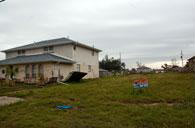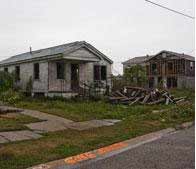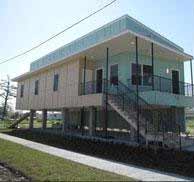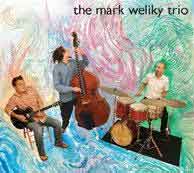HOST:
Welcome to AMERICAN MOSAIC in VOA Special English.
(MUSIC)
I'm Doug Johnson.
This week on our program ...
We visit New Orleans, Louisiana, to learn about the recovery efforts since Hurricane Katrina ...
And play music from several of the city's many jazz bands.
(MUSIC)
The French Quarter and Garden District are two of New Orleans' most famous and popular neighborhoods. Walking through these historic areas, visitors today might find it hard to believe that a deadly storm swept through the city over four years ago. However, most of New Orleans and its people are still struggling to rebuild and recover after Hurricane Katrina hit the Gulf Coast in August of 2005. Barbara Klein has more.
BARBARA KLEIN:
Katrina was the costliest and one of the deadliest hurricanes to ever strike the United States.
Jackson Hill is a photographer who has lived in New Orleans for over 30 years. He took us on a tour through the city's neighborhoods to help understand more about the storm's damage and the slow recovery process.

JACKSON HILL: "Where those cars are going over that little bridge down there where those lights is where the floodwall is. We're going to go right up to it, then we will go over to where the new pumps have been built and the floodgates."
Driving through the neighborhoods of northern and eastern New Orleans, you see many newly built or repaired houses. But there are also a surprising number of areas of empty land where houses used to stand.
JACKSON HILL: "You see, all these vacant lots, they are all houses that are not there."
Mr. Hill points out that just because you see houses, does not mean that these neighborhoods have recovered. Many houses that are standing are still wrecked and must be torn down. Some are only partly repaired. And he says that when you consider recovery, you cannot just think about the houses in a community.
JACKSON HILL: "You also gotta think about schools, fire stations, police stations. They're all gone too."
New Orleans was built on low-lying wetlands along the Mississippi River. Because of the risk of flooding, the city is surrounded by protective levees and floodwalls. But the poorly designed protection system was widely known to be too weak to protect against a major hurricane.

JACKSON HILL: "And the water here, came in like that, bang."
When Katrina hit, water levels exceeded the height and strength of many of these walls. Many walls broke, allowing billions of liters of water from the Gulf of Mexico and two nearby lakes to flood the city. Eighty percent of the city was underwater for days.
After the storm, recovery and aid efforts by local, state and federal agents were not well organized. This only added to the storm's damage.
As Mr. Hill continues driving, he points out many shopping centers that remain empty. Many businesses never reopened after Katrina's destruction. There are empty stores, religious centers and hospitals. This has made it even more difficult for many people to rebuild their lives and communities.
The Greater New Orleans Community Data Center says the city's population is about 77 percent of what it was before Katrina. Many people who fled chose to build new lives in other cities. This has had a huge effect on New Orleans economically, socially and culturally.
One area of the city that has received much media attention is the Lower Ninth Ward. More than 4,000 homes were destroyed when a nearby flood wall broke.
Actor Brad Pitt created the Make It Right Foundation to provide money to rebuild in this poor neighborhood. The organization hired top building designers to create modern, environmentally friendly houses. Many sit on tall supports in case of future flooding. One house is built like a boat so that it will rise with flood waters. So far there are about 20 of these colorful new houses. The group plans to build a total of 150 houses.

Many people have praised Brad Pitt for the work he has done in New Orleans. But others say the extremely modern design of the buildings is insulting because it is not like the design of the city's historic buildings. And some people question whether it is wise to rebuild in an area that could easily flood again. However, everyone agrees that the city is still in great need of safe and affordable housing.
Josh Neufeld is a comic book artist in New York City. After Katrina hit, he was an emergency volunteer in Biloxi, Mississippi. He wrote an Internet blog about his experiences, which later led to a book. "A.D.: New Orleans after the Deluge" uses drawings and text to tell about the real experiences of several Katrina survivors.
JOSH NEUFELD: It's a story that needs to be continued to be told. And people need to know that New Orleans is still very much a city that is in recovery. It needs to be supported and appreciated as a unique place.
Critics say this graphic novel artfully expresses the survivors' bravery and shows what it was like to live through this disaster.
(MUSIC)
HOST:
One hopeful sign of recovery in New Orleans can be found in the energy of artists who represent the city's rich culture. We spent some time in the lively Bywater and Faubourg Marigny areas to hear local musicians performing at clubs and drinking places.
(MUSIC)

That was "Definitely Maybe" by the Mark Weliky Trio. Guitarist Mark Weliky is from Florida. He moved to New Orleans to study music and enjoy the city's energetic jazz scene. He plays with drummer Paul Thibodeaux and Martin Masakowski on bass. Martin's father, Steve Masakowski, is a member of our next band, Astral Project.
Astral Project has been performing in New Orleans since 1978. The musicians are known for their inventive jazz influenced by funk, rock and world music. Here is their song "Voodoo Bop."
(MUSIC)
Tuba Skinny is a band that takes its listeners back in time to the jazz and blues music of the 1920s and 30s. The members have been playing together since April of last year. Sometimes they play in the streets of New Orleans. Other times they perform in popular bars. The band's lead singer Erika Lewis moved to New Orleans from New York state because of her love of music. We leave you with Tuba Skinny's version of "Sugar in My Bowl."
(MUSIC)
HOST:
I'm Doug Johnson. Our program was written and produced by Dana Demange. For transcripts, MP3s and podcasts of our programs, go to voaspecialenglish.com. You can also post comments.
Do you have a question about people, places or things in America? Send it to mosaic@voanews.com and we may answer it on this show. Join us again next week for AMERICAN MOSAIC, VOA's radio magazine in Special English.
levee: an embankment raised to prevent a river from overflowing 堤壩,堤岸
funk: a type of modern dance music with a strong rhythm (伴奏現代舞蹈的)鄉土爵士樂
Americans sing the praises of TV's 'Glee'
Pets2Vets Group is helping soldiers deal with stress disorder
'Sesame Street' turns 40 years old
Visitors can see the Hope Diamond all by itself soon
(來源:VOA 編輯:陳丹妮)
